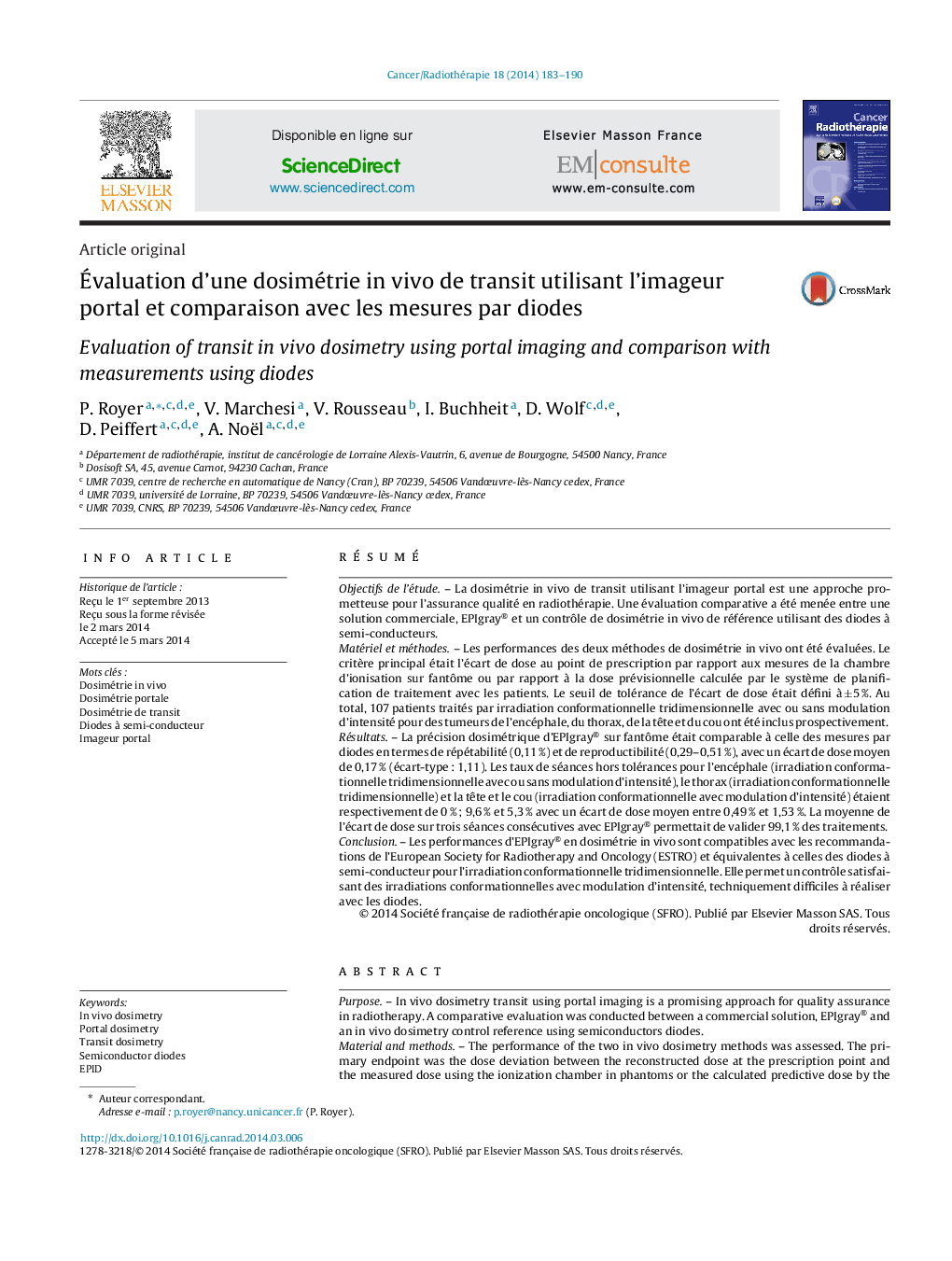| کد مقاله | کد نشریه | سال انتشار | مقاله انگلیسی | نسخه تمام متن |
|---|---|---|---|---|
| 2118222 | 1085225 | 2014 | 8 صفحه PDF | دانلود رایگان |

RésuméObjectifs de l’étudeLa dosimétrie in vivo de transit utilisant l’imageur portal est une approche prometteuse pour l’assurance qualité en radiothérapie. Une évaluation comparative a été menée entre une solution commerciale, EPIgray® et un contrôle de dosimétrie in vivo de référence utilisant des diodes à semi-conducteurs.Matériel et méthodesLes performances des deux méthodes de dosimétrie in vivo ont été évaluées. Le critère principal était l’écart de dose au point de prescription par rapport aux mesures de la chambre d’ionisation sur fantôme ou par rapport à la dose prévisionnelle calculée par le système de planification de traitement avec les patients. Le seuil de tolérance de l’écart de dose était défini à ±5 %. Au total, 107 patients traités par irradiation conformationnelle tridimensionnelle avec ou sans modulation d’intensité pour des tumeurs de l’encéphale, du thorax, de la tête et du cou ont été inclus prospectivement.RésultatsLa précision dosimétrique d’EPIgray® sur fantôme était comparable à celle des mesures par diodes en termes de répétabilité (0,11 %) et de reproductibilité (0,29–0,51 %), avec un écart de dose moyen de 0,17 % (écart-type : 1,11). Les taux de séances hors tolérances pour l’encéphale (irradiation conformationnelle tridimensionnelle avec ou sans modulation d’intensité), le thorax (irradiation conformationnelle tridimensionnelle) et la tête et le cou (irradiation conformationnelle avec modulation d’intensité) étaient respectivement de 0 % ; 9,6 % et 5,3 % avec un écart de dose moyen entre 0,49 % et 1,53 %. La moyenne de l’écart de dose sur trois séances consécutives avec EPIgray® permettait de valider 99,1 % des traitements.ConclusionLes performances d’EPIgray® en dosimétrie in vivo sont compatibles avec les recommandations de l’European Society for Radiotherapy and Oncology (ESTRO) et équivalentes à celles des diodes à semi-conducteur pour l’irradiation conformationnelle tridimensionnelle. Elle permet un contrôle satisfaisant des irradiations conformationnelles avec modulation d’intensité, techniquement difficiles à réaliser avec les diodes.
PurposeIn vivo dosimetry transit using portal imaging is a promising approach for quality assurance in radiotherapy. A comparative evaluation was conducted between a commercial solution, EPIgray® and an in vivo dosimetry control reference using semiconductors diodes.Material and methodsThe performance of the two in vivo dosimetry methods was assessed. The primary endpoint was the dose deviation between the reconstructed dose at the prescription point and the measured dose using the ionization chamber in phantoms or the calculated predictive dose by the treatment planning system with patients. The deviation threshold was set to ±5%. In total, 107 patients were prospectively included and treated with 3D-conformal radiotherapy (3D-CRT) or intensity-modulated radiotherapy (IMRT) techniques for tumours of the brain, chest and head and neck.ResultsThe dosimetric accuracy of EPIgray® in phantom were comparable to diodes in terms of repeatability (0.11%), reproducibility (0.29–0.51%) with a mean dose deviation of 0.17% (SD: 1.11). The rates of radiotherapy sessions out of the tolerance for the brain (3D-CRT and IMRT), thorax (3D-CRT) and the head and neck (IMRT) were respectively 0%, 9.6% and 5.3% with a mean dose deviation ranging between 0.49% and 1.53%. The mean of dose deviation between three consecutive sessions with EPIgray® validates 99.1% of treatments.ConclusionThe performance of EPIgray® in in vivo dosimetry is consistent with the recommendations of the European Society for Radiotherapy and Oncology (ESTRO) and equivalent to semiconductor diodes for 3D-CRT. It also allows adequate control for IMRT, which is technically difficult to perform with the diodes.
Journal: Cancer/Radiothérapie - Volume 18, Issue 3, June 2014, Pages 183–190